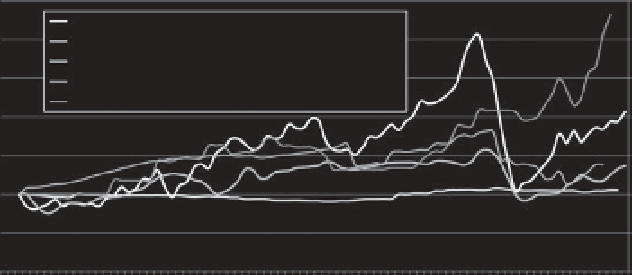Agriculture Reference
In-Depth Information
Price indices for natural fibres, crude oil and polypropylene (per Euro basia)
350
Crude Oil
300
European Flax and Hemp Short Fibres
Polypropylene Copolymere
Jute
Sisal
250
200
150
100
50
0
Fig. 12.1.
Price indices for natural fibres, crude oil and polypropylene (on a per euro basis).
other purposes. The situation is better regard-
ing sisal: here, an extension of cropping areas
is possible in the dry regions of Africa and
South America - places where hardly any other
crop can be cultivated. But European produc-
tion is also under pressure: the cropping areas
of flax are decreasing due to strong competi-
tion from areas with subsidized bioenergy crops
such as ethanol, as well as the dependency on
exports to China, which is buying less textile-
grade long flax fibres. As for hemp, an exten-
sion of cropping area is possible if rates of
return similar to those of the food and feed
sector and energy crops can be achieved.
Areas under hemp cultivation are also on the
rise in China, with hemp expected to replace
cotton in the clothing textile sector.
In December 2009, Bangladesh imposed
a ban on jute fibre exports for the first time and
it was not before February 2010 that it was
partly suspended for certain grades. The rea-
sons for the embargo were to be found in
3 years of poor harvests and increasing
demand, particularly from India (packaging)
and China (composites), threatening a short-
age of the necessary raw material from the
Bangladesh jute industry. Due to the embargo,
jute prices rose by 50-100%. At the same
time, sisal prices were increasing too, due to a
severe drought in East Africa.
Asian packaging (bags) accounts for 80%
of the jute and kenaf used, sisal particularly in
the form of tows and harvest belts. In contrast
to these, natural fibre composites still consti-
tute small markets that can be supplied quite
easily.
As a result of farmers reacting more
quickly to changes in demand, rates of return
and a local shortage of area, there has been a
general trend towards a more dynamic agricul-
tural market with more volatile prices, and this,
fuelled by speculators, is now affecting the
world of natural fibres. For a long time, prices
have been quite stable compared to other agri-
cultural products or oil. But it is expected in the
future that natural fibre prices will definitely
stay below
1/kg so that they remain attrac-
tive for composites.
Figure 12.1 shows the price developments
of important natural fibres and, as a compari-
son, the price development of oil and polypro-
pylene. European flax and hemp short fibres
have only recently shown moderate price
increases after a long period of price stability
and are currently showing particularly good
price stability - a price rise of less than 10% in
over 7 years.
To sum up: exciting times for European
hemp, which, with adequate framework condi-
tions, has considerable growth potential.
€

